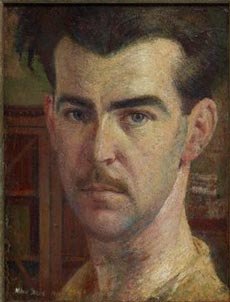Who was William Dobell?
Born in Newcastle in 1899, William Dobell came to art late. A poor student, he left school as soon as he could and was apprenticed to a local architect to train as a draftsman because he had revealed some talent for drawing as a youth. Dobell moved to Sydney in 1924, where he worked for a time as a draftsman at the Redfern workshops of Wunderlich, manufacturers of architectural metalwork and terracotta. His flair for drawing resulted in a move to the firm’s advertising department and evening classes at Julian Ashton’s Sydney Art School, where he began serious studies in drawing and painting. It was only then, as he approached the age of 30, that Dobell realised his true vocation.
Awarded the Society of Artists Travelling Scholarship in 1929, Dobell left for London and stayed for ten years. While there he studied briefly at the Slade School, but spent most of his time consolidating his formal training by drawing as much as he could and painting, often painstakingly, small-scale oils. He exhibited little, preferring to quietly develop his skills and powers of observation, making genre, landscape, portrait and character studies and supplementing his income with commercial art and odd jobs. He associated with other artists, mostly Australians, who supported each other materially, as well as artistically, in hard economic times. However, he gained most from his concentrated observation of the work of the old masters in London and various European museums.
On his return, Dobell was received almost immediately as an artist of considerable substance. Hailed by many as the greatest Australian portraitist ever, official acclaim and popular fame attended much of his career. In large part, this stemmed from the widespread controversy generated by the Archibald Prize of 1943 – which Dobell was awarded for a portrait of Joshua Smith – and the infamous court case that followed it.
While he was known for landscapes and genre paintings, it was his major portraits, including those of Margaret Olley (1948), Dame Mary Gilmore (1957) and Helena Rubinstein (1963), that cemented his reputation. He was knighted in 1966, and died in 1970.
Adapted from Contemporary Australian drawing: 20 years of the Dobell Drawing Prize
View all works by William Dobell in the Gallery’s collection

William Dobell Self portrait 1932 © courtesy Sir William Dobell Art Foundation